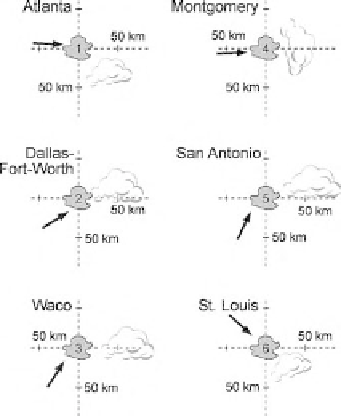Geoscience Reference
In-Depth Information
Figure 7.10 TRMM
satellite summary of
downwind precipitation
enhancement for five cities
in the southern United
States. The arrow indicates
the prevailing wind, and the
cloud the enhanced area of
precipitation. (After
Shepherd et al.
2002
)
Included for comparison is
St Louis from earlier ground-
based analysis. (From Brazel
and Quatrocchi
2005
)
terrain, adjacent water bodies and shorelines, problems associated with point
measurements being unrepresentative, inconsistent spatial distribution analysis,
and lack of knowledge about urban interactions with different synoptic weather
types. However, more recent evaluations of precipitation distributions down-
wind of urban areas using satellites suggest urban influences are real. For
example, Shepherd et al.(
2002
) used the precipitation radar on the Tropical
Rainfall Measuring Mission (TRMM) satellite to assess the spatial distribution
of rainfall over three years for five cities in the southern United States. They
found an average increase in warm-season monthly rainfall rates of 28% at
locations 30 to 60 km downwind of the urban center, compared to upwind areas
(Figure
7.10
). Maximum rainfall rates downwind increased by 48 to 116%.
7.7 Effects of air pollution
Throughout this chapter, there has been regular referral to air quality in cities and
its relation to the components of urban climate. GEO (
2003
) provides a summary
of major air pollution problems in cities around the world. While air pollution
problems have abated somewhat in developed cities, such as in the United States
and Europe, they are increasingly serious in rapidly developing cities, such as in
India, China, and Southeast Asia. The main sources are industry and the ever-
increasing traffic fleet.
There is a wide range of air pollutants in the urban environment. Gases are
mainly created through the burning of fossil fuels and evaporation from liquids,
and are emitted from the surface to the atmosphere as primary pollutants.
Examples include sulfur dioxide, nitrogen oxides, carbon monoxide, and volatile
organic hydrocarbons, which are mainly of urban and regional concern, and

Search WWH ::

Custom Search